Taking Advantage of Evening Longbeards Written by Kendal Doerksen
For most hunters, the arrival of warmer weather after a long winter means one thing: turkey season.
In order to increase the odds of having a successful evening hunt there are six main factors that should be considered: location, observation, access, cover, calling, and decoys.
________________________________
For most hunters, the arrival of warmer weather after a long winter means one thing: turkey season. Spring turkey hunting is often illustrated with early morning wake-up calls and longbeards gobbling on the roost. All too often this excitement subsides after the birds fly down from their roost and each gobble grows increasingly distant or the gobbling stops altogether. If your morning hunt doesn’t pan out the way you had hoped, the evening shift can be a great time to punch your spring turkey tag.
In order to increase the odds of having a successful evening hunt there are six main factors that should be considered: location, observation, access, cover, calling, and decoys. Every factor may have different applications depending on the geographical location you are hunting. However, the main tactics can be effectively transferred to your hunting area and result in some tasty, free-range poultry on your dinner table.
NOTE: Before scouting or hunting an evening location it is important to check your state or provincial regulations on legal shooting hours during the spring turkey season to ensure that evening hunting is legal in your area.
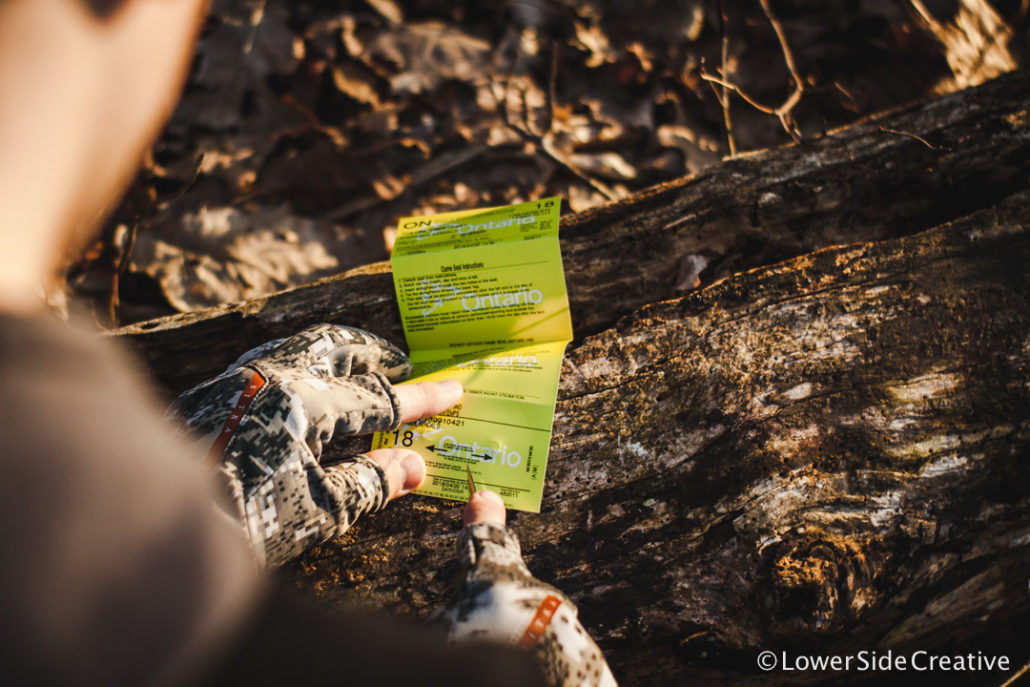
Scouting: Where to Look
Scouting is crucial to all types of hunting but it is exponentially more important in the case of evening turkey hunts. Gobblers will most likely be less vocal and setting up in the correct location is crucial to success. Scouting relevant locations begins with an understanding of a what a turkey does during the evening hours. During the late afternoon and evening a longbeard will oftentimes enter an open area to feed and strut with hens that are in the area before going back to his roosting location.
Examining and designing setups specifically for evening hunts is crucial to a successful hunt. A good morning hunt location is not always a good location for an evening hunt although this sometimes can be the case. Scouting is a way to verify when and where you should be hunting specific areas.
There are two important aspects to an evening hunting location; food and high visibility. These two aspects will vary from one area to the next. For example, in big timber, a logging road may be a high visibility strutting location relative to the habitat in that area. Other locations may include but are not limited to; harvested grain fields, clear cuts, prescribed burn areas, pasture ground or powerline clearings provided that the area is not grown into tall grasses and shrubs.
Due to the large amount of agriculture in my area, I spend the majority of my time on cut corn and soybean fields. Hay and winter wheat fields may also provide suitable locations. However, from my visual observations as well as checking turkey crops (the pouch near the throat of a turkey where food is temporarily stored), turkeys appear to have a preference for leftover grains.
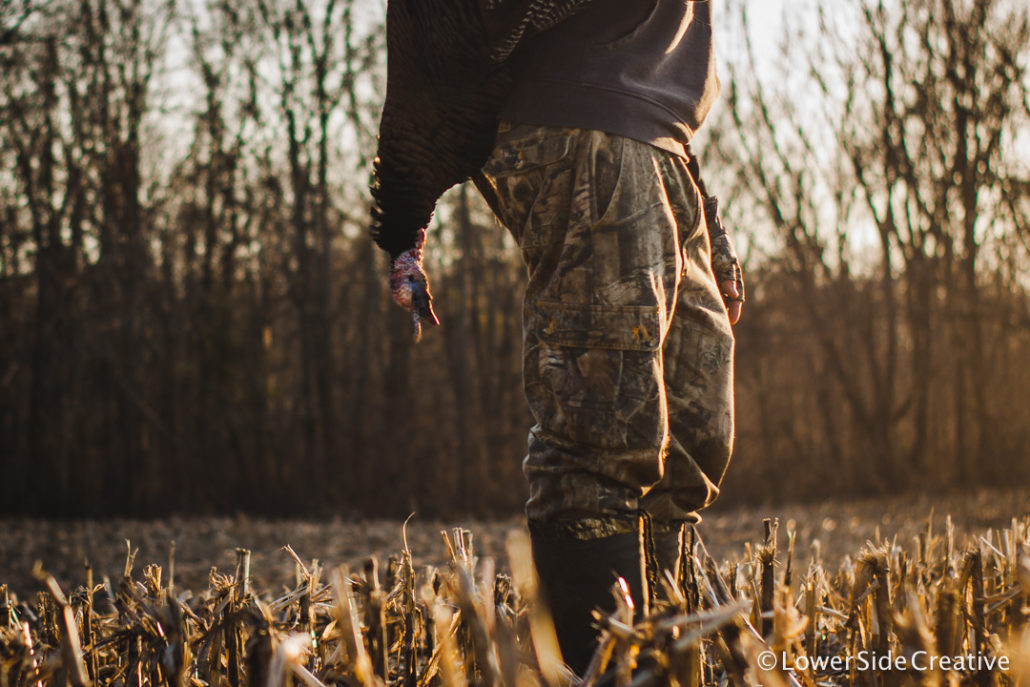
Observations: Finding a Pattern
Once you have compiled a list of potential locations for an evening hunt, the next step is to grab a pair of binoculars or a spotting scope and spend time behind the glass. Find a location that allows you to see a vast amount of ground without being intrusive. Most of my glassing is done from the roadside though this may not be applicable in all situations and you may have to change your tactics depending on the section you are scouting.
First you need to determine if there are turkeys in the area and more importantly if there is a turkey you would like to pursue. If you find a turkey that is to your liking, you must then examine your target’s movements. Every turkey follows a pattern throughout its day. There is no cookie-cutter pattern for all turkeys to follow but they will remain on a relatively consistent pattern as long as they feel safe doing so.
Once you have analyzed a potential pattern, you must determine a suitable ambush site. It is important to set up in an area that the turkeys want to be, not in an area where you will have to call them to your position. Once you have settled on a location, your next step is to execute the plan.
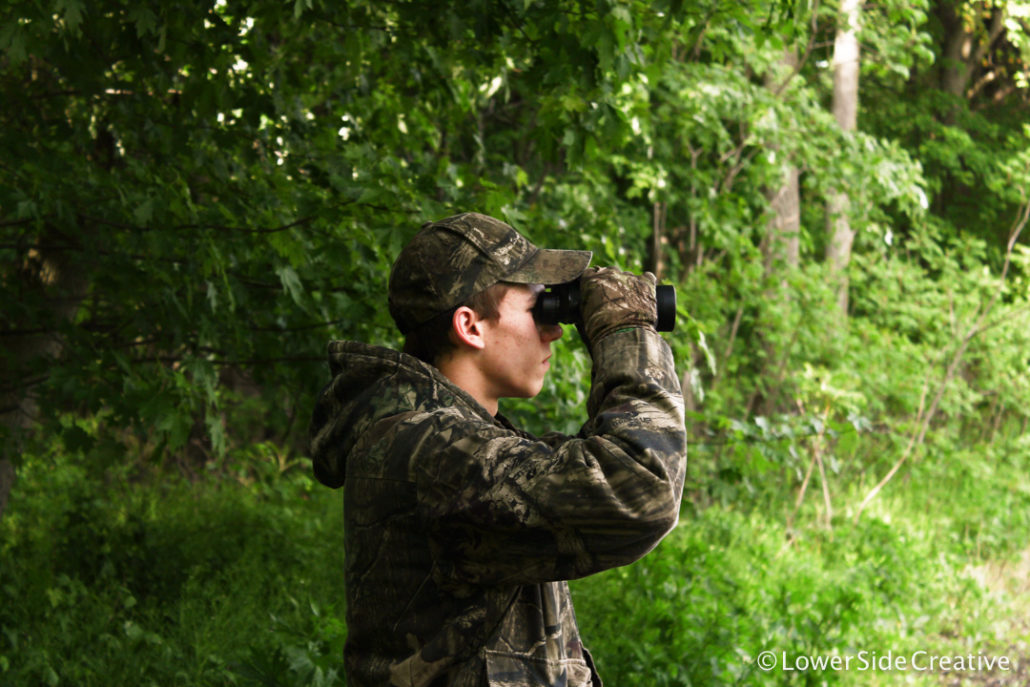
The Setup: Accessing the Area
The term access is extremely popular in the whitetail hunting world but is rarely talked about for a turkey hunt. Considering a turkey’s lacking sense of smell, walking towards a pre-dawn gobbler is relatively easy. Setting up on an evening longbeard will require some extra thought. Below is an example of how I used access to tag an evening turkey during last year’s season:
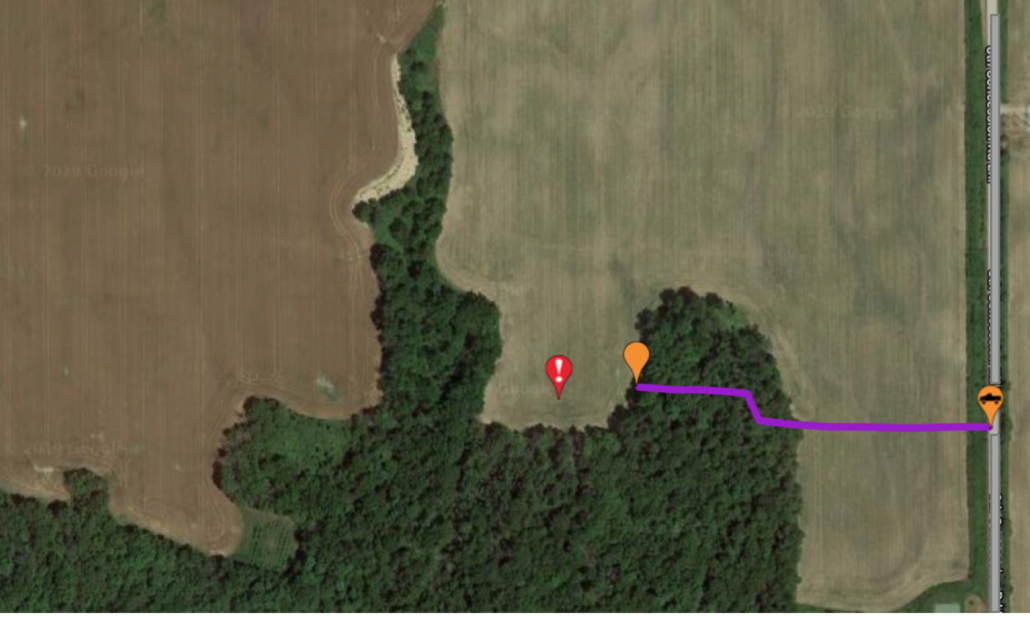
The red marker represents a tom I had observed several days prior to the hunt. Walking through the middle of an open field is never ideal though it was possible in this case due to the lay of the land. The timber acted as a visual barrier between myself and the predicted pattern of the turkey I was hunting. Moving through the timber with extreme caution, I made regular stops to glass the field ahead for any movement, allowing me to setup without any issues.
The tactics used in this example can be applied to many different situations. Just remember these three points: slow movement, a visual barrier, and scanning open areas. If your access results in a spooked turkey, that’s pretty much game over. Better luck next time
¨Before scouting or hunting an evening location it is important to check your state or provincial regulations on legal shooting hours during the spring turkey season to ensure that evening hunting is legal in your area.¨
Hide Yourself: Ground Blinds and Ghillie Suits
The question of whether or not to use a ground blind is often a personal one. I prefer to go without one, though in certain situations it is necessary due to the lack of natural cover. Choosing a ground blind may also depend on how many people you are hunting with, if you are hunting with children or an elderly person, and how long you are planning on sitting. Unlike when deer hunting, a pop-up blind can be easily moved from one location to the next without worry of changing a turkey’s pattern. Overall, a ground blind can be an effective means of hiding from an approaching gobbler particularly if you can’t stay still for a long period of time.
If there is a wealth of cover available to you, a ghillie or 3D suit can be a phenomenal option in terms of camouflage. Ghillie suits can be relatively inexpensive and are extremely effective at breaking up your outline which can be crucial in fooling a turkey’s keen eyesight. A 3D suit is not a requirement; many other camouflage clothing options will suffice. However, a ghillie suit may allow you to get away with just enough movement to punch a tag on a spring longbeard that otherwise may have busted you.
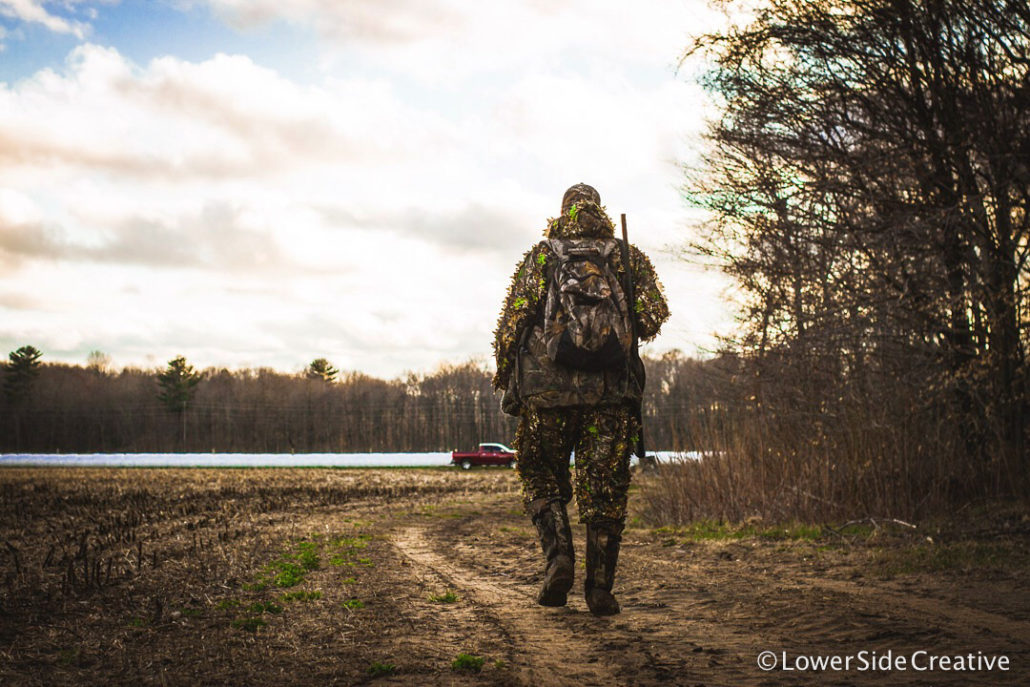
Getting Vocal (or Not): Calling Tips
In terms of the types of calls to use for evening turkeys, I would recommend that you use the call you feel most comfortable with. Choose any call that you believe sounds best, although I would caution against using a box call as they are often too loud and aggressive for an evening hunt. Most pot or mouth calls will suffice, more important than the type or brand of call you decide to use is how you use it.
Generally during the latter part of the day, toms and jakes are not nearly as aggressive and your calling style should follow suit. Soft yelps and purrs are often the best option, however, if a gobbler is very vocal I will in turn become more aggressive as long as I’m not over doing it. Overcalling is one of the biggest mistakes that every turkey hunter has made, oftentimes calling followed by silence is the most productive tactic. I’ve gone into an area, let out a few yelps and after receiving no response, sat in silence for the next two or three hours. Relying on scouting, your set-up, and patience can be the best way to enjoy a successful evening hunt.
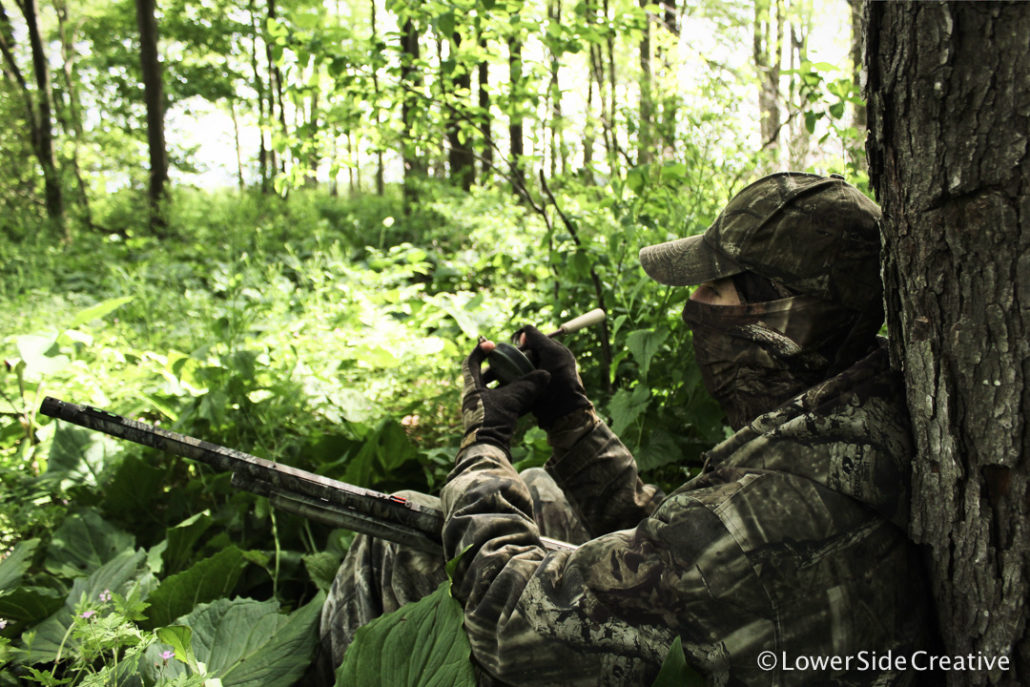
Visual Attractant: Decoys
Although turkeys as aggressive during the evening hours, decoys can still be an extremely efficient means of drawing in a longbeard. Evening locations are often strutting zones which are a space for toms to interact with the hens in the area. For this reason, I have found that a two hen setup can be very effective and often times for the sake of weight I will carry a single hen in with me. There are a large number of relatively realistic decoys on the market that will suffice. I would recommend avoiding the extremely cheap foam decoys though. In the long run a well-made, realistic decoy is going to be a better investment for consistently killing evening turkeys.
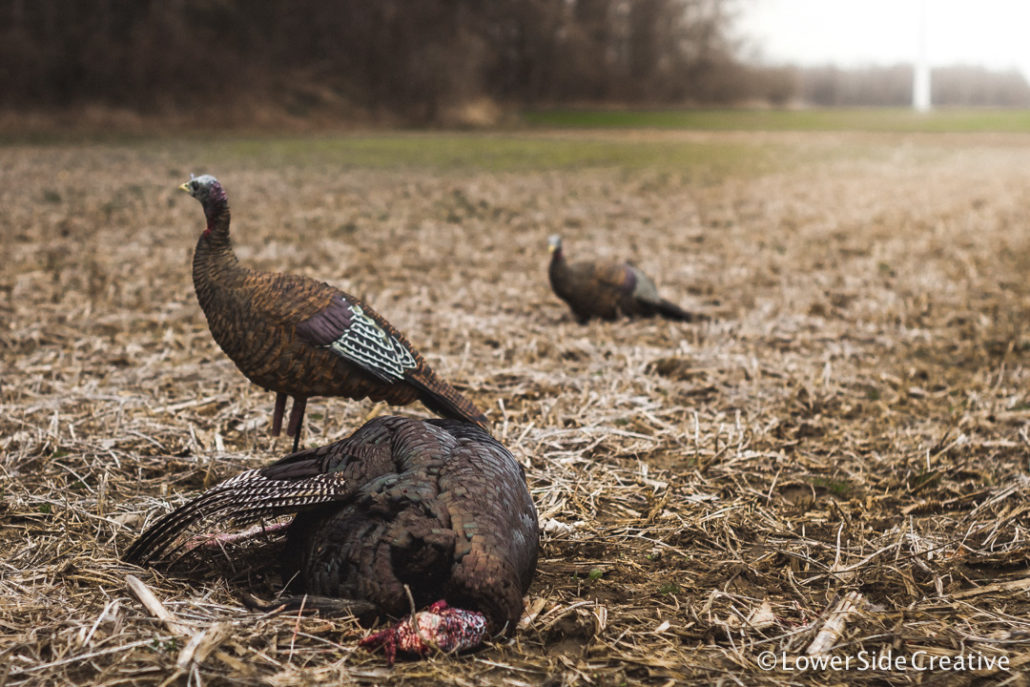
Conclusion: Dinner on the Table
Not only can hunting the evening shift for turkeys allow you to spend more time in the spring woods, it can also be an effective time to add some meat to the freezer. As the season progresses, a turkey’s pattern may evolve due to hunting pressure, agricultural practices, and changes in food sources. As these changes happen, re-scouting the area is often crucial to staying in the game. I say it often but in terms of evening turkey hunts it is particularly fitting, “Don’t doubt the scout”.
Share this entry
- hunting
- small-game
Interesting links
Here are some interesting links for you! Enjoy your stay :)Pages
- About
- Accesories
- Accesories & Equipment
- Accesories & Equipment
- Advertisement Contact
- Ammo
- Big Game
- Blog
- Bow Hunting
- Cart
- Community
- Deer
- Download Hafaspot
- Equipment
- FAQ
- Fire Arms
- Fishing
- Fresh Water
- Grill
- Home
- Home | FIND YOUR SPOT
- home 2
- Hunting
- Login and registration
- Lures
- My Account
- News
- News
- News
- Página de ejemplo
- Payment
- Prime Cuts Recipes
- Salt Water
- Shooting
- Small Game
- Store
- Targets
- Wild Caught Recipes
- Wild Game Recipes


